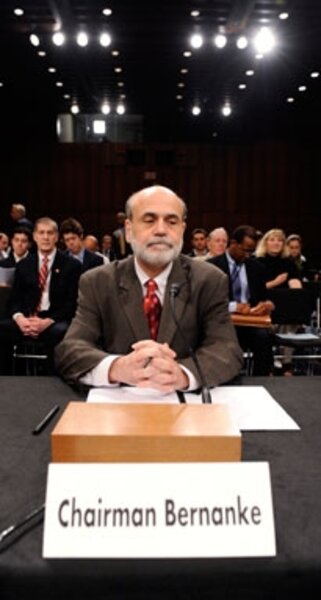Bernanke looking ahead to bailout 'exit strategy' as fears lessen
Loading...
Welcome to Ben Bernanke’s new economy: It’s a world where the US must figure out how to start pulling back from costly stimulus efforts even as the economy itself hasn’t recovered from recession.
The new challenge for the Fed and the whole economy came into focus as the Federal Reserve chairman spoke to a congressional panel Tuesday.
On the one hand, Mr. Bernanke faced persistent questions from lawmakers about whether America’s central bank will be able to contain inflationary pressures against a backdrop of rising federal spending, record budget deficits, and big stimulus from monetary policy. He responded that the Fed has been developing an “exit strategy" to address these concerns.
On the other hand, the Fed chairman’s assessment of the current economy is that it’s too soon to say a recovery is at hand, and that even when growth resumes, the rate of unemployment will remain high. These concerns tempered Bernanke’s tone as he cited signs of progress in the economy.
“The housing market [has] shown some signs of bottoming,” he said in his prepared statement. “We continue to expect economic activity to bottom out, then to turn up later this year.”
Bernanke hastened to add that economic growth “is likely to remain below its longer-run potential for a while,” and “businesses are likely to be cautious about hiring, implying that the unemployment rate could remain high for a time.”
If the Fed reins in its stimulus too soon, it might choke off forces of recovery in the name of fighting a problem that hasn’t shown up yet. If the Fed stays too supportive of the economy for too long, the result could be inflation.
Promising signs
Bernanke isn’t the only one who sees some promising trends in the economy.
In the midst of a deep housing slump, it takes more than a comment from the Fed for financial markets to decide the trouble is over. But from an early March low, the US stock market has risen more than 33 percent in value.
Bond markets have shifted significantly, with less money fleeing to the haven of Treasury bonds and more willingness among investors to hold private-sector debt. President Obama, meanwhile, has talked about “glimmers of hope.”
The factors causing this optimism include:
• A dialing down of perceived risk. Interventions by the Fed and Treasury to prop up faltering financial industry have been costly, but they have been successful in easing fear of a chaotic meltdown in which credit dries up.
• The arrival of stimulus. Mr. Obama’s $787 billion spending and tax-cut package is starting to provide a boost to economic activity, and the Fed itself has enlarged the money supply, considered a feedstock of growth.
• Stabilization in consumer behavior. Consumer spending rose in the first quarter of 2009, after dropping in the previous half year. This could boost employer confidence enough to reduce the pace of job cuts.
Bernanke can’t promise that the financial panic is over. But for now at least, he and the nation are starting to focus on different problems ahead.
Lawmakers pressed the Fed chief on whether he has an exit strategy. How, they asked, will he pull back from all the stimulus and rescue efforts before they result in inflation or in costly burdens for taxpayers?
“We are spending an enormous amount of time” developing an exit strategy, Bernanke said. “We are very committed to price stability.”
He said many of the Fed’s emergency lending programs can be wound down fairly easily as private credit markets get back to business.
Since the financial crisis reached its peak last fall, the Fed has been stepping in as a “lender of last resort” to banks and private-sector firms that suddenly found themselves less able to find financing.
Bernanke said the programs, while not the Fed’s business during normal times, amount to profitable and safe lending. Thus, while economic rescue efforts at the US Treasury are costing taxpayers lots of money, the central bank doesn’t expect to turn to taxpayers.
Balancing concerns
Still, Bernanke acknowledged that the exit-ramp issue is a tricky one, taking up as much as half the discussion time at two-day policy meetings that top Fed officials hold every few weeks.
“How do we make sure that the monetary base contracts at the appropriate time?” Bernanke asked. “There’s risk on both sides, and we’re trying to manage,” he said.
He cautioned against worrying too soon about inflation at a time when unemployment is rising and US factories have a lot of spare capacity. “We don’t expect to see much inflation” in that environment, he said.
In fact, he said an economic recovery should not be taken for granted. The Fed forecast of growth reviving later this year hinges on the assumption of a continued healing in credit markets, he said.
Rep. Ron Paul (R) of Texas pushed Bernanke to comment on what the Fed would do in a scenario where inflation heats up without an economic recovery.
Bernanke said he viewed that as unlikely but in that case, he would focus on price stability, because of the damage that out-of-control inflation can have on an economy.
He tried to counter concern that, with federal budget deficits shooting above $1 trillion a year, the Fed would face political pressure if the Treasury has trouble finding buyers for all the bonds it has to issue.
They will not “monetize the deficits” by allowing higher inflation (in a bid to lower the government’s real debt burden), Bernanke insisted.
Still, the questions point to a challenge for the government. The government's total outstanding debt could roughly double between 2008 and 2012, according to some forecasts.
If bond buyers grow more cautious about the prospects of being paid back in un-inflated dollars, the Treasury’s cost of borrowing could rise while the government is still trying to put the economy back on track.





